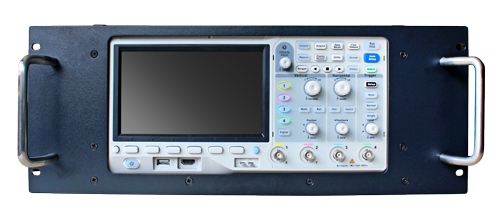Product Overview
SIGLENT’s SDS1000X-U Super Phosphor Oscilloscopes are available in one bandwidth, 100 MHz. SDS1000X-U Oscilloscopes have a maximum sample rate of 1 GSa/s and a maximum record length of 14 Mpts. For ease of use, the most commonly used functions can be accessed with its user-friendly front panel design.
The SDS1000X-U series employs SPO (Super Phosphor Oscilloscope) technology that provides excellent signal fidelity and performance. It comes with an innovative digital trigger system with high sensitivity and low jitter, and a waveform capture rate of 400,000 frames/sec (sequence mode). The SDS1000X-U also employs a 256 level intensity grading display function and a color temperature display mode not found in other models in this class.
Another powerful addition is the new 128 k point FFT math function that gives this digital oscilloscope a very high-frequency resolution when observing signal spectra. Siglent’s SDS1000X-U also supports searching and navigating. The features and performance of the SDS1000X-U cannot be matched anywhere else in this price class.
| Bandwidth | Channels | Real time sampling rate | Capture rate | Memory depth | Price | ||
| SDS1104X-U | 100 MHz | 4 | 1 GSa/s | 4 00,000 wfm/s | 14 Mpts | $399 | Buy Now |
Key Features
- 100 MHz bandwidth
- Real-time sampling rate up to 1 GSa/s
- The newest generation of SPO technology
- Waveform capture rates up to 100,000 wfm/s (normal mode) and 400,000 wfm/s (sequence mode)
- Supports 256-level intensity grading and color temperature display modes
- Record length up to 14Mpts
- Digital trigger system
- Intelligent trigger: Edge, Slope, Pulse Width, Window, Runt, Interval, Time out (Dropout), Pattern
- Serial bus triggering and decoding (Standard), supports protocols IIC, SPI, UART, CAN, LIN
- Video trigger, supports HDTV
- 10 types of one-button shortcuts, supports Auto Setup, Default, Cursors, Measure, Roll, History, Display/Persist, Clear Sweep, Zoom and Print
- Segmented acquisition (Sequence) mode, divides the maximum record length into multiple segments (up to 80,000), according to trigger conditions set by the user
- Automatic measurement function for 38 parameters as well as Measurement Statistics, Zoom, Gating, Math, History and Reference functions
- History waveform record (History) function (maximum recorded waveform length is 80,000 frames)
- 128 k pts FFT, supports Peaks and Markers
- Math functions (FFT, addition, subtraction, multiplication, division, integration, differential, square
root) - Large 7 inch TFT LCD display with 800 * 480 resolution
Product Characteristics
7 Inch TFT-LCD Display and 10 One-button Menus View more
7 Inch TFT-LCD Display and 10 One-button Menus
- 7 -inch TFT -LCD display with 800 * 480 resolution
- Most commonly used functions are accessible using 10 different one-button operation keys: Auto Setup, Default, Cursor, Measure, Roll, History, Persist, Clear Sweep, Zoom, Print
Record Length of up to 14 Mpts View more
Record Length of up to 14 Mpts
Using hardware-based Zoom technologies and max record length of up to 14 Mpts, users are able to oversample to capture for longer time periods at higher resolution and use the zoom feature to see more details within each signal.
Waveform Capture Rate up to 400,000 wfm/s View more
Waveform Capture Rate up to 400,000 wfm/s
With a waveform capture rate of up to 400,000 wfm/s (sequence mode), the oscilloscope can easily capture the unusual or low-probability events.
256-Level Intensity Grading and Color Temperature Display View more
256-Level Intensity Grading and Color Temperature Display

- SPO display technology provides fast refresh rates. The resulting intensity-graded trace is brighter for events that occur with more frequency and dims when the events occur with less frequency.
- The color temperature display is similar to the intensitygraded trace function, but the trace occurrence is represented by different colors (color “temperature”) as opposed to changes in the intensity of one color.
Serial Bus Decoding Function (Standard) View more
Serial Bus Decoding Function (Standard)
SDS1000X-U displays the decoding through the events list. Bus protocol information can be quickly and intuitively displayed in a tabular format.
History Waveforms (History) Mode and Segmented Acquisition (Sequence) View more
History Waveforms (History) Mode and Segmented Acquisition (Sequence)
Playback the latest triggered events using the history function. Segmented memory collection will store trigger events into multiple (Up to 80,000) memory segments, each segment will store triggered waveforms and timestamp of each frame.
True measurement to 14 M points View more
True measurement to 14 M points
SDS1000X-U can measure all sampled data points up to 14 Mpts. This ensures the accuracy of measurements while the math co-processor decreases measurement time and increases ease-of-use
Gate and Zoom Measurement View more
Gate and Zoom Measurement
Through Gate and Zoom measurement, the user can specify an arbitrary interval of waveform data analysis and statistics. This helps avoid measurement errors that can be caused by invalid or extraneous data, greatly enhancing the measurements’ validity and flexibility.
128 k points used to calculate the FFT View more
128 k points used to calculate the FFT
The math co-processor enables FFT analysis of incoming signals using up to 128 k samples per waveform. This provides high frequency resolution with a fast refresh rate. The FFT function also supports a variety of window
functions so that it can adapt to different spectrum measurement needs. SDS1104X-U oscilloscopes support Peaks, Markers, a variety of numbers.
Hardware-Based High-Speed Pass/Fail View more
Hardware-Based High-Speed Pass/Fail
The SDS1000X-U utilizes a hardware-based Pass/Fail function, performing up to 40,000 Pass / Fail decisions each second. Easily generate user defined test templates provide trace mask comparison making it suitable for longterm signal monitoring or automated production line testing.
Search and Navigate View more
Search and Navigate
SDS1000X-U oscilloscopes can search events specified by the user in a frame. It can also navigate by time (delay position) and historical frames.
Complete Connectivity View more
Complete Connectivity
SDS1000X-U digital oscilloscopes support USB Host, USB Device (USB-TMC), LAN (VXI-11), Pass/Fail and Trigger Out
Standard Accessories
PP510 100 MHz Oscilloscope probe















